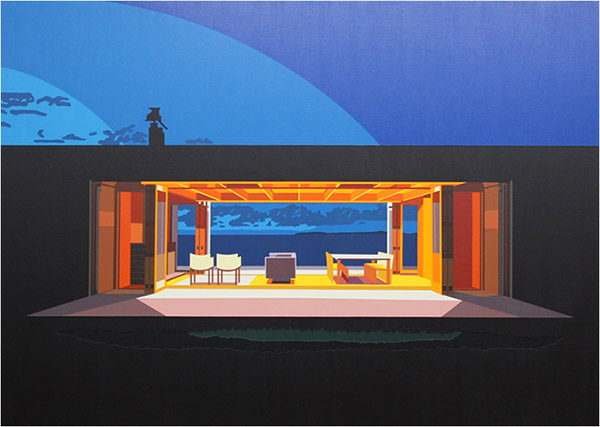 home
about
artists
exhibitions press
contact
purchase
home
about
artists
exhibitions press
contact
purchase |
|
|
Will Martyr
The
Escape Artist ‘We shape our buildings, and afterwards our buildings shape us’. Winston Churchill Will Martyr’s stylish paintings highlight the fascinating influence of architecture on the mind. The images in his new exhibition Stay Until Tomorrow read like a catalogue of structures designed to bring about a sense of well-being. As the environments we occupy are processed and interpreted by all our senses, they inevitably contribute to identity and an overall satisfaction with daily life. Although we’ve become cynical we still secretly long for something gloriously unexpected, that the rabbit will be pulled from the hat, ears and whiskers intact. In our modern culture, beauty has been replaced by functionality; darker and uglier concrete blocks overshadow our streets, contributing to vague feelings of claustrophobia. Contrary to the ubiquitous slogan, it does not feel like we are ‘worth it’, but just another cog trapped in a vast grey, windowless machine. These bigger and better and taller Towers of Babel are monuments to power- but leave us isolated and straitjacketed. Somewhere we’ve misplaced the importance of horizontal breathing space, under the suffocating desires for the vertical. Martyr’s paintings such as ‘Well To Do’ and ‘It’s Only Us’ are a real release for your tired eyes. Here, from a relaxed and reclined view, the world finally looks ‘right’. Things are aligned, fitting together seamlessly; edges are smoothed out, all shapes are levelled and evenly spaced. The canvases feel familiar, with sheets of light softly slanting through glass, hushing your jangled nerves as though you were stood under the arching ceiling of a cathedral. Inside is like outside: the roof as endless as the sky, walls billowing out like sails in the wind, quietly drifting out upon the grassy sea. The sweeping lines are reminiscent of rolling hills and distant horizons, even though there are no trees left to speak of. This artist’s technique is both architect and magician; every precise brushstroke is a sleight of hand to lull and seduce. We know that there is more here than meets the eye, but find comfort in the illusion. He does not attempt cerebral explanations of architectural psychology, but hints at our deep seated longings for freedom with his visions of the perfect tomorrow. These are truly bewitching blueprints, designed to restore connection between the inner and outer world.
Maurizio Camatta
Ariadne’s Thread ‘The capacity to be puzzled is the premise of all creation, be it in art or science’ Eric Fromm Maurizio Camatta’s works create exciting atmospheres, illuminating the natural curiosity of the spectator. Brilliant flashes of lightning and layers of charged elements blaze in the gathering gloom, creating his Electrical Storms. Within these canvas clouds, electrons knock knees with rising damp, kettled by the fierce outside forces. Geomagnetic clashes burn hotter than the sun, with auroras like haloes and ripping through the material of the sky. Beautifully lit on the gallery walls you find yourself wondering if the paintings would glow, even with the blinds drawn, and the lamps dimmed several octaves lower. Unusually, Camatta finishes his abstracts with threads, as though they were musical instruments from a fantastical space orchestra. With more than a nod to string theory, they appear to be dissections of the ‘stuff’ we are made of. Like super magnified particles, the colours darkly vibrate their universal symphony, hinting at hidden things beyond our reach. In front of these works it is easy to marvel at our origins, to imagine a multi-verse of black holes, interstellar gasses and extra dimensions, to predict our eventual fate. Camatta is the ultimate chromatographer, revealing another layer just the other side of what is perceived. As in a school science experiment, we see that blackness is not nothingness. Just as the felt pen separates into its colourful components on filter paper, so space is not actually empty but stuffed full of dark energy. It may seem like science fiction to start talking of ideas like cross-dimensional gateways, but our endless investigations have already identified previously unimagined pieces of the puzzle: up/ down/ strange/ charm/ bottom/ top quarks, neutrinos, muons, tuons and electrons. We are relentless in our pursuit of the elusive Higgs boson that will complete the jigsaw and give us The Theory Of Everything. This missing piece still nettles us today about life’s meaning. We question the existence of a ‘God particle’, blaming butterflies for triggering tornados. So how long is a piece of string theory? Ancient texts described ‘this and yonder world and all beings (as) strung together’. They speculated about the ropes connecting earth to sun, and the mysterious solar winds. The Upanisadic philosopher Gargi first challenged the sage Yajnavalka about ‘the thread on which all worlds are interwoven’, many moons before we began to unravel string theory. Perhaps these ideas have always been there, laid out to help find our way through this Minotaur’s labyrinth. |
|
| The exhibition is held alongside a sculpture collection which features works by Oleg Prokofiev, Eleanor Cardozo, Nicola Godden, Richard L.Minns, Andy Cheese, Jamie McCartney, Ian Edwards, Gianfranco Meggiato, Massimiliano Cacchiarelli Principi and Palolo Valdés. | |
|
|
E-mail: info@hayhillgallery.com |

